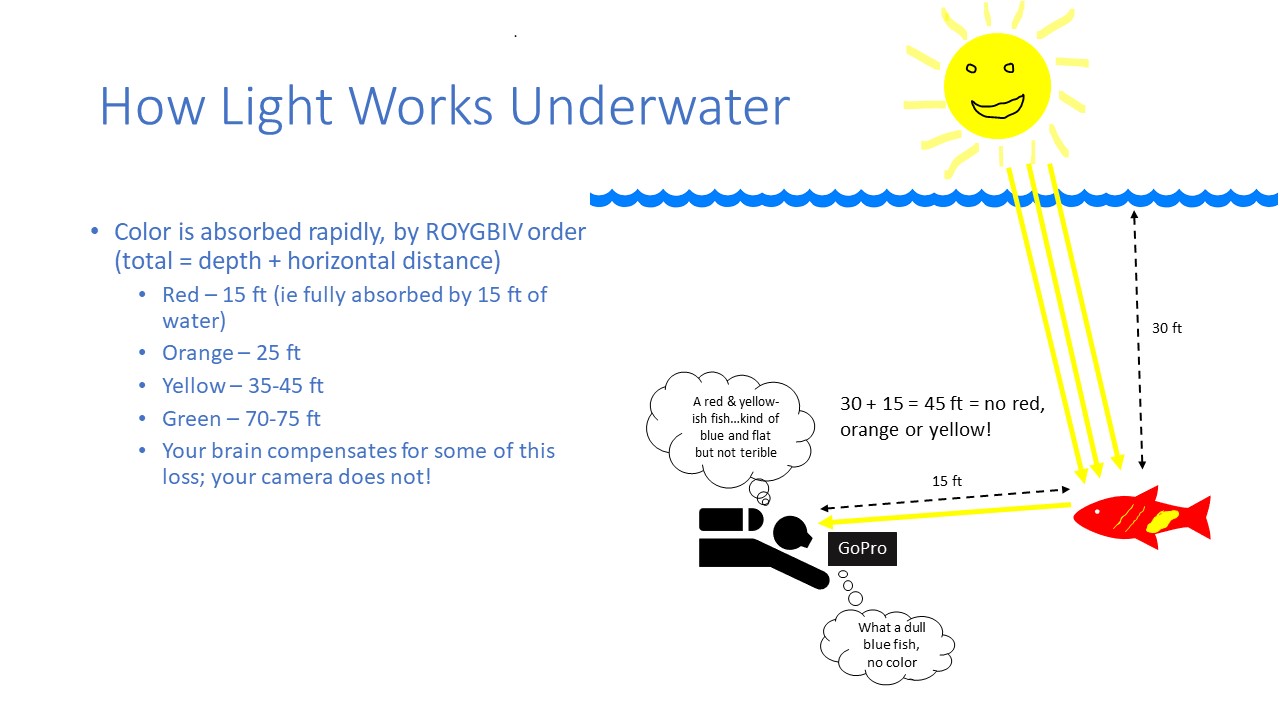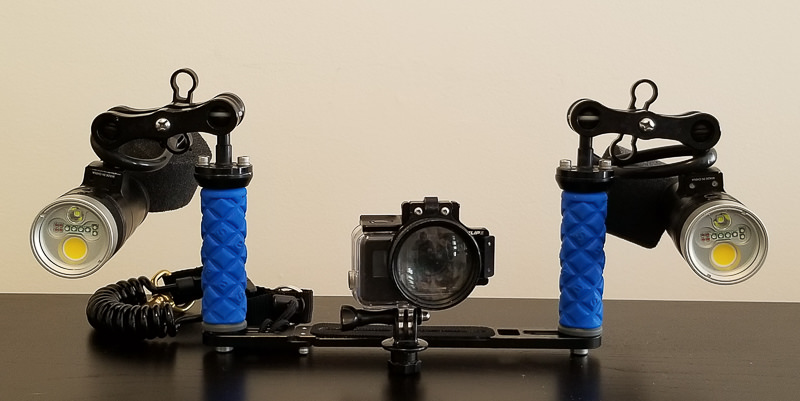Getting professional-quality video by using video lights with a GoPro
Aug 12It seems that everywhere you go diving these days, someone has a GoPro with them. And why not? They are very small, affordable, and easy to use. Because of this, there is a ton of underwater footage out there taken by GoPro. I am sure you have seen lots. Some of it is really nice, but along with that, there is also a lot of dull, blue, colorless, and frankly pretty boring stuff out there.
While travelling over the past year, my partner Lisa and I took a lot of GoPro video, and used it to make professional-looking underwater videos. As an underwater photographer, I am always thinking about lighting – more importantly, how to light up my subjects in a way that shows the brilliantly beautiful colors of the underwater world. Just as in photography, with video, the most important ingredient is lighting. GoPros can and do take exceptional, high-quality video when provided with the right lighting conditions. The problem with most underwater GoPro footage is not the GoPro itself, or the subject matter, but rather the lighting.
How Light Behaves Underwater
Water absorbs light very quickly, starting with the slowest wavelengths – red, then orange, then yellow. After passing through only 15 ft of water, light loses all red wavelengths, and then the other colors follow.

GoPro Version Matters
Before I go too far, let me qualify the piece about lighting. Great lighting with an old GoPro will give you decent footage, but old GoPros can’t compete with the latest GoPro image quality. The performance step change from the GoPro 5 to the GoPro HERO6 Black was massive. Check out the underwater photography guide’s review of the GoPro HERO6 Black. The improvement from the 6 to the 7 was not very big for image quality, but it was huge for image stabilization. So to get nice image quality from your GoPro, upgrade to at least a 6. If you want incredibly smooth, professional-looking footage when shooting handheld, the 7 is by far the best choice, as you can see in the GoPro HERO7 Black detailed review.
What Lighting to Use?
My partner Lisa, being new to underwater imaging, was at first very resistant to using any lights with the GoPro. Lights are big, heavy, and expensive. Doesn’t that defeat the whole purpose of the GoPro? So we started off with a Light & Motion Sidekick Duo, which is a very compact underwater light designed to be connected directly to the GoPro mount, thus not adding much in the way of size or weight. In some situations it added some nice color, but overall we found it was just too limited in terms of positioning, power and beam angle. Some videos it would add some nice color, but others it would create a hotspot on the subject, or just light up a ton of particles in the water, making it look like it was snowing.
We also used a Sealife Aquapod Mini, which gave us extra reach with the GoPro, theoretically allowing us to get closer to subjects without scaring them. It was useful when snorkeling with sharks in French Polynesia, and for dipping in the water from a boat to capture action at the surface. However, for day-to-day use while diving, we found that the benefit of getting closer to subjects was outweighed by the disadvantage of having the GoPro on a long stick; stability. It was very hard to get stable video, especially in any kind of current. Not to say a setup with a Sealife Aquapod and Sidekick light are bad; I would say it is a pretty decent setup for casual snorkelers who just want some videos of their trip so they can remember things. However, we were interested in higher quality video.

Our current GoPro rig – Hero 7 black, Macromate mini flip diopter, tray with ball mounts, 2x Kraken 3500+ WRSU lights.
As it became apparent that we had outgrown our video setup, and wanted something better, we decided to go for it. We bought a tray with handles and two small video lights. This is when things got good. The tray helped us get stable video – holding the GoPro close to the body with two hands was a lot more stable than holding it on a long stick with one hand. And we could not place the tray down on a rock or on the sand to get it really stable. We tried some different lights, including SeaLife Sea Dragon 2000 lumen lights, which gave us some nice results. Now we have landed on the Kraken 3500+ WRSU lights, which provide a ton of power, as well as versatility of modes: flood beam, spot beam, red light and UV light, all with different power settings available.
Check out our sample footage using the Sealife Sea Dragon 2000 lumen lights below, and you can read more about these lights on the UWPG’s Sealife 2000 lumen video light review. The review also contains a comparison video showing footage taken with two lights vs footage taken with just a red filter, vs footage taken without any lights or filters.
How Many Lights? How Many Lumens?
For wide angle video, having one light is much better than no lights, and also much better than a filter. However, having two lights will allow you to position them further away from the GoPro lens, which means you light up less particulates in the water and get cleaner video.
The amount of lighting power you need depends on the conditions you will be using them in. The brighter the ambient light, the more powerful the video lights need to be, if you want to overpower the dull blue ambient light and restore the colors. Though if you go really shallow, you can capture nice colors with ambient light, especially with the sun at your back. So with that said, a good starting point for light power is the 2000-4000 lumen range. Under 2000 lumens and you really don’t have enough power or reach for many situations, and over 4000 lumens you are starting to get into higher end, more professional light systems. With 2000 lumen lights, you can get very nice colors, but only if you are no more than 1-2 feet from your subject. Anything more than that and you’ll want more lumens…but even with really powerful video lights you won’t see much effect beyond about 5 ft.
On the other end of things, if you really want the best quality underwater video you can get, then go for the 10,000 lumen + range – it sure will look nice! The store recently got in the new Sola Pro 12,000 and 15,000 lumen lights, which will give you some amazing video quality.
For macro video, you have to bring the lights in close anyway, so one light should do the trick. A second light does give you more lighting options, but you can make very nice macro video just using one. If you want to learn more about shooting GoPro macro video, check out our beginner’s guide to GoPro macro video, up on the UWPG. Additionally, since you will only be a few inches from your subject, 2000-3000 lumens is more than enough light for nice, bright colors and sharp details.
The below sample macro footage is shot with a GoPro 7 and Macromate mini, and a variety of video light powers (2000, 2500 and 3500 lumens). Without lights, macro video tends to look quite colorless and flat, as expected…it really loses its magic. So I would not recommend trying your hand at macro without a light!
The Bottom Line
We have used our GoPro with tray, video lights and macro lens to create promotional videos for a few dive resorts, and they have all been very happy with the results.
As they say in the movies…lights, camera, action! With just the camera, and no lights, you can get some decent footage under ideal conditions (ie at or near the surface of the water). But if you really want to get consistently great underwater footage, you need all 3. Sufficiently powerful video lights, a GoPro 6 or 7, and some great underwater action!
Hit me up at bryan AT uwphotographyguide.com if you have any questions!





Related Articles
Popular Articles